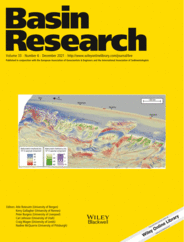
Full text loading...
 , Dougal A. Jerram3,4, Sverre Planke1,4, Bineet K. Mund5, Shubhodip Konar5, Ruchika Sharda5, Dwarika Maharjan1, Tanzeem Patankar5
, Dougal A. Jerram3,4, Sverre Planke1,4, Bineet K. Mund5, Shubhodip Konar5, Ruchika Sharda5, Dwarika Maharjan1, Tanzeem Patankar5
The Deccan Traps large igneous province (LIP) comprises one of the largest continental flood basalt provinces on Earth with the main phase of volcanism spanning the Cretaceous‐Palaeogene boundary. The oldest volcanism of the province is encountered in the northwest of modern‐day India where Deccan stratigraphy is often buried beneath thick Cenozoic sedimentary sequences. The Raageshwari Deep Gas (RDG) Field, located onshore in the central Barmer Basin, NW India, produces gas from the early Deccan Raageshwari Volcanics which are subdivided into two members, the Agni Member and the overlying Prithvi Member. The RDG comprises a globally important example of a producing volcanic reservoir whilst also offering unique insights into the early volcanism of the Deccan with the aid of extensive high quality sub‐surface data. Within this study, the volcanic facies of the RDG sequences are investigated from five cored intervals (total 160 m). Core‐based facies determinations are compared with geochemical analyses, petrophysical analyses of the cores (density, porosity and permeability), and wireline data including micro‐resistivity borehole images (FMI) and Nuclear Magnetic Resonance (NMR) data. A wireline based volcanic lithofacies scheme is developed and applied to the uncored parts of the sequence which in turn is compared to 3D seismic data. Results of the study reveal the Agni Member to comprise a compositionally bimodal (basalt through to trachyte), dominantly alkaline series with mixed volcanic facies including spectacular felsic ignimbrites, basic‐intermediate simple lava flows, volcaniclastic units and newly identified shallow intrusions. The Prithvi Member in contrast is dominated by tholeiitic basalt compositions with less common basic‐intermediate alkaline compositions and comprises a sequence dominated by classic tabular lava flow facies inter‐digitated with boles, volcaniclastic units, rare compound braided lava facies and evolved tuffaceous ash layers. In one interval of the Prithvi Member, evidence for agglutinated spatter is recorded inferring potential proximity to a palaeo‐eruption site within the area. Comparison between core data and volcanic facies reveals a first order control of volcanic facies on reservoir properties highlighting the importance of volcanic facies appraisal in the development of volcanic reservoirs.
,Summary conceptual model, graphic facies logs and core examples from the mixed basic and felsic volcanic reservoirs of the Raageshwari Deep Gas Field, NW India.

Article metrics loading...

Full text loading...
References


Data & Media loading...

